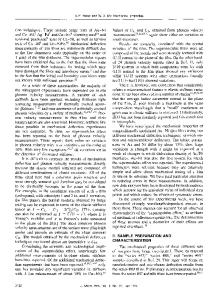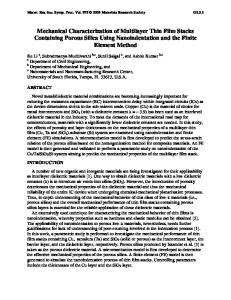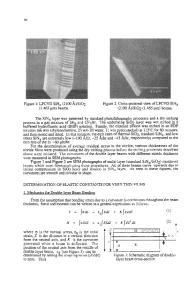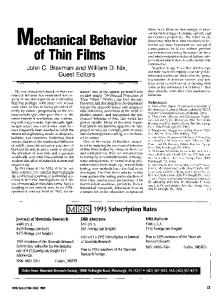Analyzing the mechanical behavior of thin films using nanoindentation, cantilever microbeam deflection, and finite eleme
- PDF / 1,038,624 Bytes
- 10 Pages / 612 x 792 pts (letter) Page_size
- 24 Downloads / 326 Views
O. Kraft Institut für Materialforschung II, Forschungszentrum Karlsruhe, and Institut für Zuverlässigkeit von Bauteilen und Systemen, Universität Karlsruhe, Karlsruhe, Germany (Received 6 June 2003; accepted 13 October 2003)
A comprehensive study was undertaken to identify the extent to which the mechanical properties of thin metal films on substrates could be determined quantitatively from instrumented sharp indentation. The mechanical behavior of thin Cu films on substrates was investigated using three different methods: nanoindentation, cantilever microbeam deflection, and microtensile testing. Finite element calculations of the nanoindentation and microbeam deflection experiments were conducted to extract yield strength and hardening modulus. Systematic experiments were performed to investigate the consistency of the different experimental techniques. The mechanical behavior of the Cu films was observed to depend on the film thickness. However, the results from finite element modeling of nanoindentation and microbeam deflection are quite different. In both cases, unique solutions for yield strength and hardening modulus were found. This is particularly noteworthy for the nanoindentation experiments; it is argued that the substrate destroys the self-similarity that is present during indentation of bulk material using a Berkovich tip. Microbeam deflection experiments seem to be more sensitive to the elastic–plastic transition, whereas the nanoindentation results describe the mechanical behavior at larger plastic strains. This is corroborated by microtensile tests. I. INTRODUCTION
It is well known that the mechanical properties of polycrystalline thin metal films depend on the film thickness and on microstructural parameters such as grain size and texture. Specialized testing techniques have been developed to study the mechanical behavior of materials in reduced dimensions, including microtensile or bulge testing, nanoindentation, and microbeam deflection. These techniques aim at determining material properties such as Young’s modulus, yield strength, strain hardening rate, and tensile or fracture strength in small volumes (Refs.1–3 for reviews). During the past decade, interest in indentation has increased significantly; first, because sample preparation is less elaborate than for other testing methods, and second, because of the noticeable improvement of indentation equipment. With this improvement it is now possible to monitor with high precision both the load and the displacement of an indenter during indentation
a)
Present address: Massachusetts Institute of Technology, Cambridge, MA 02139. J. Mater. Res., Vol. 19, No. 1, Jan 2004
http://journals.cambridge.org
Downloaded: 20 Mar 2015
experiments in the micro-Newtons and nanometer ranges, respectively. For nanoindentation, Berkovich tips, which are sharp three-sided pyramids, are commonly used. A load is applied to the tip, and the tip penetration into the material is measured. The contact stiffness between tip and the material tested is then determined
Data Loading...











